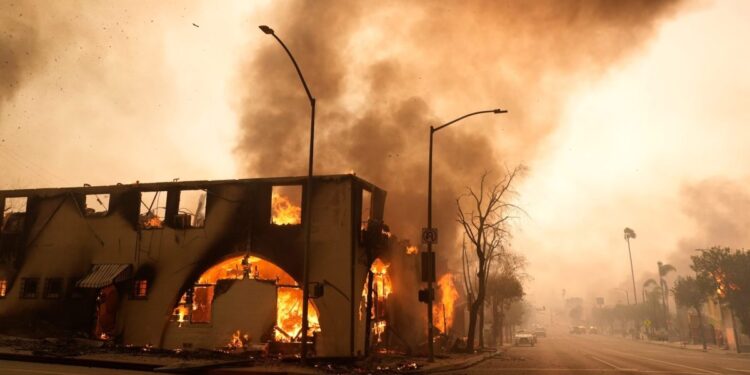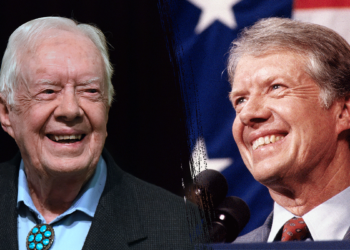The ongoing Los Angeles wildfires have reportedly killed at least 5 people and destroyed thousands of structures, leaving entire neighborhoods in heaps of ashes.
With stately homes burned to the ground, or too damaged to imminently return to, wealthy Angelenos reportedly fled to hotels or other cities: Those who could afford the nightly rate of more than $1,000 stayed at the posh Beverly Hills Hotel, according to a Wednesday night dispatch from the LA Times. Others, the New York Times reported, went to the Sunset Tower Hotel in West Hollywood, where Thursday night’s cheapest rate was listed online at $512. Some drove the 30 miles southeast to the city of Anaheim, where several hotels are offering discounted stays.
But the plight of people experiencing homelessness in the city—reportedly more than 45,000 as of last year, which marked a decrease from 2023—have been comparatively invisible in the wall-to-wall coverage. On Thursday afternoon, I called up John Maceri, the CEO of the People Concern, a social services organization in LA that oversees 700 shelter beds, to learn more about the barriers facing unhoused people trying to flee the wildfires. Their struggles, he said, range from lacking cell phones and Internet access, which can prevent them from learning about evacuation orders and resources, to coping with health issues from all the time spent outside inhaling wildfire smoke. With homelessness reaching record levels in the US last year and natural disasters increasing as a result of climate change, the challenges Maceri outlined seem less like anomalous hardships and more like harbingers of what’s to come as more Americans grapple with the dual housing and climate crises.
This interview has been lightly condensed and edited for clarity.
What is your staff seeing on the ground in terms of the impacts of the fires on unhoused people?
We do direct service work in a few ways for people experiencing homelessness. We have street outreach teams that are working with unsheltered people, who obviously have been displaced like everybody else has been displaced.
Then we’ve been working with people in temporary interim counseling sites, and we actually had to evacuate two of them last night because of the fire. These are Inside Safe facilities, which are part of the mayor’s initiative, and they’re both in Hollywood. There was a fire, the Sunset Fire, that broke out spontaneously about six o’clock last night, and both of those facilities are in the immediate evacuation zone. We had to move about 100 people between the two sites. It was pretty hectic. There were a few motel rooms close to the fire zone area, and then the balance of people we moved to another one of our facilities that we were just using as a triage facility temporarily. Fortunately, they were able to get that fire under control, and the evacuation orders were lifted this morning, so we spent today getting people moved back into those facilities.
I would say in terms of that unsheltered population on the ground, because the fires are active, the teams cannot be out on the streets engaging with people. For people who do have cell phones—and a lot of our clients don’t—we’ve been staying in contact with them, via phone, working to get them to evacuation centers. Transportation is a challenge, because we can’t go into fire areas, and in many cases public transportation is not operating.
So how do you go about trying to reach unhoused people in evacuation zones, both because you can’t necessarily drive into them, and then because many of them don’t have cell phones?
Well, we can’t. If people don’t have cell phones, it’s impossible. And if we’re physically blocked from getting to them, there is no communicating with them. What happens in those situations is when they’re in areas where there are first responders on site, we’re hoping that they are following the directions of the first responders and following people out through the evacuation corridors. [Editor’s note: The Los Angeles County Homeless Services Authority said in a post on social media late Wednesday night that outreach teams “have not yet been cleared to go into any of the current fire zones,” but that they continue working with service providers, helping people in need access motel rooms through a city-run program, and distributing masks in areas with poor air quality.]
A lot of the news coverage has focused on the affluence of the Pacific Palisades. But I imagine there are unhoused people there who are being impacted. Which areas are seeing the most significant impacts to unhoused people?
Yeah, the Palisades definitely has unhoused people. [Editor’s note: Last year, Pacific Palisades Task Force on Homelessness, a local volunteer-run organization, reported contacting about 300 people in the area experiencing homelessness—a number that Maceri said was an accurate estimate of unhoused locals.] We work in Malibu, the Palisades and Santa Monica, and in terms of the direct fire impact, the Palisades and the southern part of Malibu are having the most impact in terms of unhoused people there. The number of housed people, of course, is hugely impactful—there are thousands of people that have lost their homes. There are unhoused people up in the Eaton Canyon fire as well, which is farther east.
What were some of the challenges unhoused people in the LA area were facing before the fires, and what are the new ones emerging as a result of the fires?
Obviously a lack of affordable housing is a major driver in creating homelessness and sustaining and increasing homelessness. We have a very expensive and tight real estate market in L.A., and so not having enough adequate affordable housing has been fundamental to our homelessness challenge for a very, very long time.
That’s going to only be exacerbated. Any loss of housing stock is going to put more pressure on whatever housing stock has left. So people who are unhoused and are very poor are already competing in a very tight and expensive real estate market, which has just gotten tighter and more expensive because the availability of rental property is just going to tighten up. You’re going to have a lot of displaced people who are going to be renting, being forced to rent while they’re rebuilding. So that is going to further shrink the available units.
In terms of longer term impacts, I think access to healthcare—the air quality here is just horrible. Anybody who has any kind of pulmonary disease, asthma, or any kind of chronic health condition is going to struggle for a while. We know that access to health care for people is already really challenging, and I think it’s going to be even more challenging. Public spaces just aren’t as available and are going to be even less available as the recovery efforts are happening.
We’re already getting, in some areas of the city and county, orders to boil water, because the water sources have been contaminated—so to rely on public water sources, that’s going to be a challenge for people. Access to public toilets and bathrooms, which is already limited, is even more limited. People who were unhoused before the fires have limited access to all those things that I described, and after the fires are going to have even less access.
What are some other groups of particularly vulnerable unhoused people who are likely struggling now, in light of these evacuation orders, and who could struggle in the future?
People who are seniors, who have mobility issues and rely on public transportation, which is already disrupted. These things will all recover at some point, but these systems that people rely on just to get around, the things we take for granted—most Angelenos can hop in their car, Los Angeles is already limited in terms of our public transportation system. Just trying to walk across the street or navigate getting around a whole lot of devastation is going to be really hard for folks.
People who need access to medication or other kinds of health treatments, those systems are going to be strained for a while. We’re hearing already from our hospital partners that they’re starting to see more people come in to the emergency department.
Where can unhoused people staying in evacuation areas go?
While the evacuation centers are open and operating, they can use those.
There is some available temporary interim housing through the homeless response system. It’s not like we have a lot of vacancies already, but there will be some ability for folks to come indoors.
But it’s not like there’s going to be hundreds or thousands more new beds available all of a sudden. Frankly, what will happen is for people who don’t have any of those options, they will continue to live on the streets and find other areas that are less physically impacted.
What sort of prejudices do unhoused people face as they seek safety in a natural disaster like this?
I think it’s probably similar to some of the prejudices that unhoused people face even not in natural disaster: This idea that they’re not part of a community, or they don’t belong “here”; the idea that if they really wanted to be indoors, they would be.
Is the city doing enough, do you think, to help support residents who are unhoused in the wake of this?
Well, I think the city is doing a lot, in fairness, both the city and the county of Los Angeles. The fierceness and the speed at which these fires spread have been incredible. First responders are really working hard with the city and the county’s emergency response folks. We have been in communication with them constantly, they have been very responsive to us—as helpful as they can be, given the enormity of the problem and how resources are stretched, both human and other resources. [Editor’s note: Press contacts for Los Angeles Mayor Karen Bass did not immediately respond to questions from Mother Jones on Thursday afternoon.]
Homelessness is a huge problem in Los Angeles. It was before the fires. It’s going to continue to be. And I think what we’ve seen is the city and county of Los Angeles working in tandem with service providers to bring as many people indoors as possible. We’re going to have to sustain those efforts—and it’s going to be even more critical now, because we have more unhoused people. Some of those folks will be able to stay in hotels or motels or stay with family or friends, but some of them won’t. So that’s going to put even more pressure on our homeless response system in Los Angeles. My advocacy will continue to be that we have to keep our focus on bringing and keeping as many people indoors as possible.







